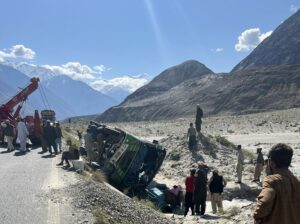It is not always wise to share everything on SoMe, and sometimes there is not enough space to do it.
So let me here share some of the details that I have not mentioned or elaborated on the SoMe channels. Reveal the secrets, so to say.
But first my status as of writing (April 14, 2023):
I am home in Denmark. Although I was home in January, some important and unexpected work came up that I must deal with from here. And being back in work mode is ok, but I look forward to continuing my endeavor, it is a longtime dream after all. But on the positive side, it is a beautiful time in Denmark right now, after a long winter spring has arrived, with flowers blooming, longer days, and more daylight. It is my favorite time of the year in Scandinavia. And I can spend some time with my family, I will never get enough of that.
I don’t know exactly when I will fly back to continue my journey, as it is now my best bet is the end of April/beginning of May.
Since I started the trip I have done around 24,000 km and visited 23 countries. When I fly back to Thailand I will continue north, enter Laos, and then Cambodia. I have never been to any of the countries, so I look forward to exploring them. But right now both the Northern part of Thailand as well as Laos is heavily polluted with smoke from the burning rice fields and forests, so it is a bit of a blessing in disguise I had to fly back home. When the rain comes sometime in late April everything will be back to normal.
Overall, the trip has so far been a great success. I have met so many people on my way and I have seen so many beautiful places. I feel so blessed and grateful that I have this opportunity.
But when you travel like me there are also obstacles you have to overcome.
So, let’s get behind the curtains:
Armenia fightings:
In September 2022 I flew from Denmark back to Armenia. Toto was stored at the Camping 3Gs and I stayed there some days to get accustomed to the simple life again. I planned to drive south toward the border to Iran as soon as possible.
While chilling at 3Gs, tensions at the border between Armenia and Azerbaijan escalated into a series of deadly shootings, resulting in multiple fatalities and injuries on both sides. The violence quickly increased, with both sides accusing the other of provocation. Armenian authorities claimed that Azerbaijani forces had launched an unprovoked attack, while Azerbaijan blamed Armenia for violating the ceasefire and firing on their positions.
The shootings continued for several days, with both sides deploying heavy weaponry and artillery. The violence resulted in the deaths of Armenian as well as Azerbaijani soldiers, and many were injured on both sides. Civilians in the border villages were also caught in the crossfire, with numerous homes and buildings damaged or destroyed.
The areas were on my route to the Iranian border and there was no other route, besides a huge 4–5-day detour through Georgia and Turkey.
When I was assessing the situation, some overlanders arrived at the 3Gs. There were coming from the south and were quite shocked. They had wild camped in Armenia near the border to Azerbaijan the night before and woke up with heavy artillery firing over their heads. They were pretty scared and the Armenian military urged them to move north as quickly as possible. So, they had to pack their things in a hurry in pitch dark and move through the area in the middle of the night with the sounds of shooting weaponry around them. Not the best recommendation for going that way.
However, after some days of intensive watching of the local news things seemed to calm down. Other overlanders on the 3Gs, going the same direction as me were quite hesitant to leave as you never know if the situation would evolve back to worse, even to a full-blown war. But as I wanted to avoid the huge detour, I started one early morning from the 3Gs moving south to the Iranian border. If you start early, it is a one-day drive and the first half part is on the road following the border to Azerbaijan.
On my way through Armenia, I met a lot of militaries, including huge trucks carrying missiles, squad vehicles, and roadblocks. I talked my way through the control posts but to be honest, it was not that pleasant, and I instinctively bent my neck and watched for missiles going over me. But fortunately, I made my way through, left the border areas, and had a pleasant drive for the rest of the day.
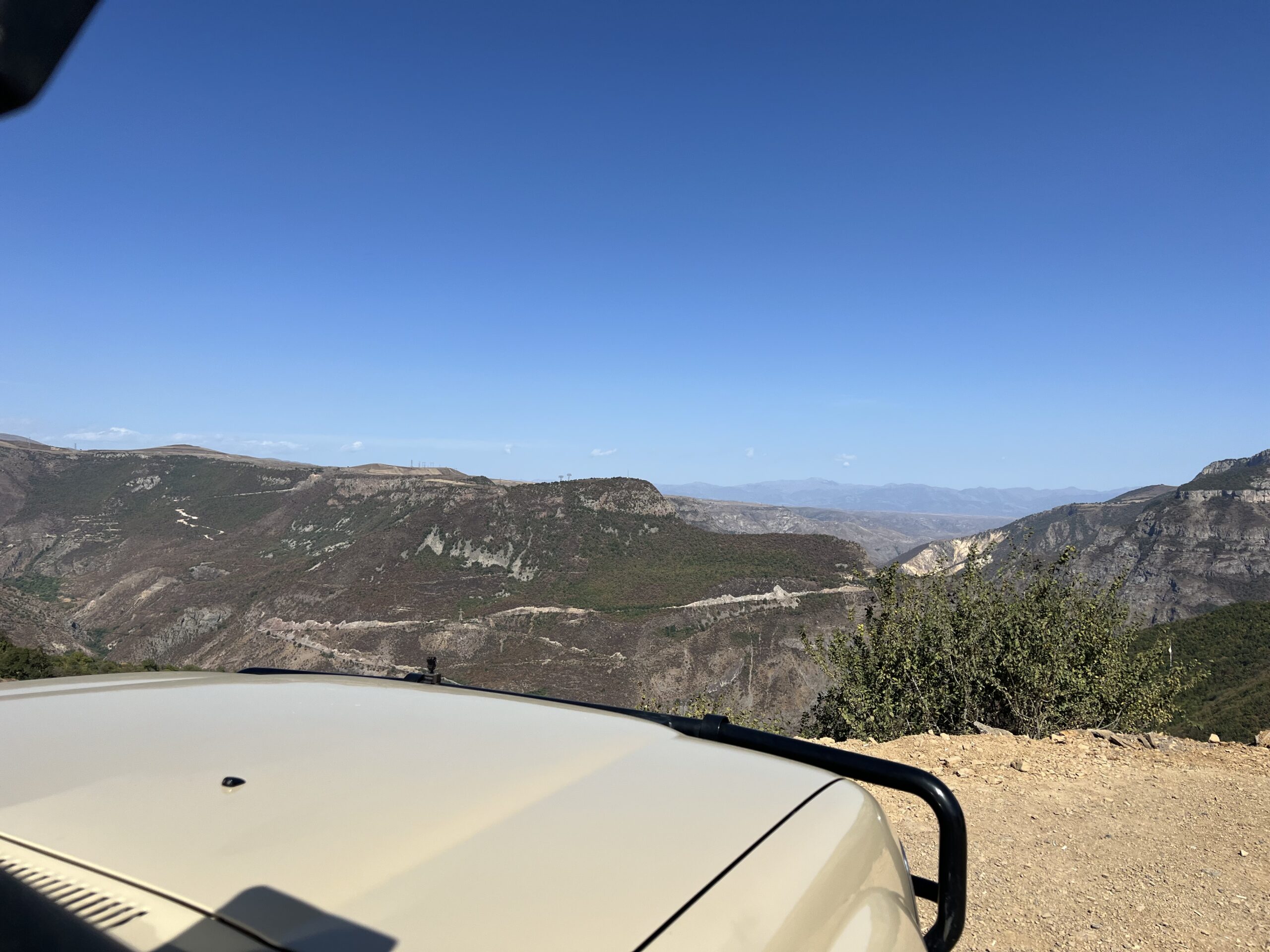
In Armenia, Azerbaijan is behind the hills
Iranian protests:
In September 2022, as you know, Iran was hit by a wave of riots and protests that erupted in several cities across the country. The unrest was sparked by a combination of economic hardship, political discontent, and public frustration with the government’s handling of the COVID-19 pandemic.
The demonstrators’ demands ranged from economic reforms to political freedoms, with many calling for an end to the Islamic Republic’s authoritarian rule. The government responded with a heavy-handed crackdown, deploying riot police and security forces to disperse the crowds and arrest protesters.
The riots were further escalated by the tragic death of Mahsa Amini, a 26-year-old Iranian woman who was arrested during the protests and died in police custody.
Entering Iran under such circumstances made me extremely vigilant. I had been to Iran two times before and had experienced the Iranian people as some of the nicest in the world. I never had any contact with the Iranian authorities though. From the news about the riots, I read that they also arrested foreigners if they were in the wrong place at the wrong time, just seemed to act suspiciously or as leverage for a later exchange of Iranian prisoners abroad.
Also, taking pictures can be problematic. You are not allowed to take pictures of government buildings, including nuclear plants as well as military and police personnel, and if you do, you can face serious troubles. And in recent times several overlanders have ended up in Iranian prisons for flying drones on the wrong places.
Crossing the border was not a problem, besides the usual paperwork on both the Armenian and Iranian sides. But as I knew there would be riots in the bigger cities, I decided to try to avoid them on my route through Iran.
Going southeast I spent one night in Tabriz and moved on to Zanjan, where I spent another night. After that, I continued south with a safe distance to Tehran and then ended up in Dorud, a midsize city not so far from Isfahan. As I had been driving quite a lot I decided to spend some nights there in a hotel. I had never been to Dorud before but I had read that Dorud is a stop on the Trans-Iranian Railway, going from the Caspian Sea in the north to the Persian Gulf in the south and that the section from Dorud to the city of Andimeshk is considered to be one of the most scenic train rides in the world.
As the timetables were in Persian the female receptionist at my hotel helped me book tickets for the next day. Also, as the train ride took 6 hours, I needed to stay overnight in Andimeshk and then take the train back to Dorud the day after so she arranged a hotel for me in Andimeshk. The receptionist and the rest of the staff in the hotel were so nice.
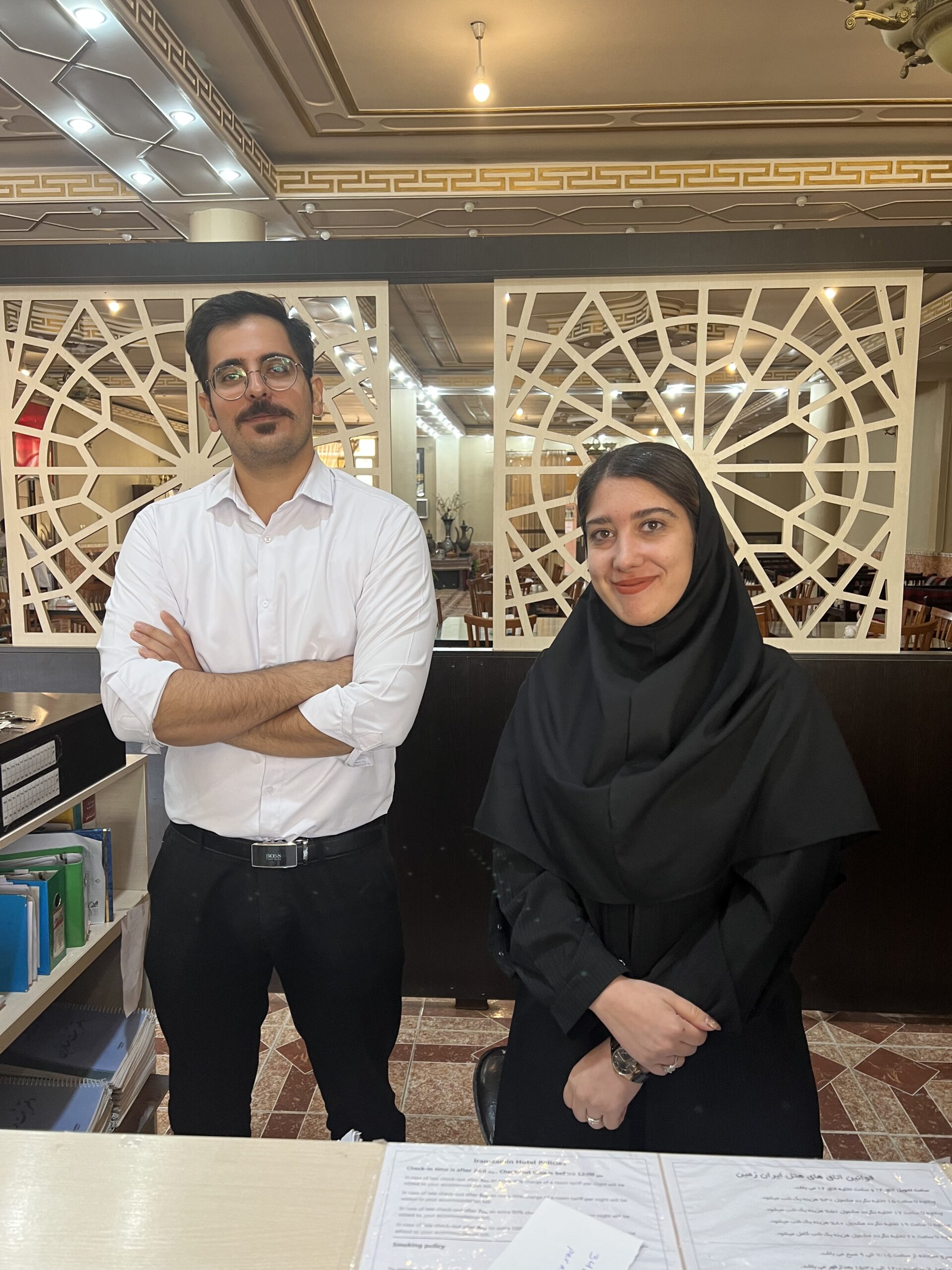
The staff at the hotel in Dorud
The day after, when I was going to the station the receptionist even went with me to secure, I got the right ticket. Before entering the train I had to go through a security check and they thoroughly took pictures of my passport, including my prior Iranian visas as well as the US sticker visa in my passport. They also took a picture of me. Ironically, the reason I had a US sticker visa in my passport was that due to my prior visits to Iran, I could no longer enter the US through the ESTA system but had to book an interview at the American Embassy in my home country where they questioned me about my trips to Iran and once secured I was not an Iranian spy, they issued me a 10-year sticker visa to the US.
I was the only foreigner to enter the train so I had some eyes on me in the third-class coach. Nobody could speak English so the conversation was sparse.
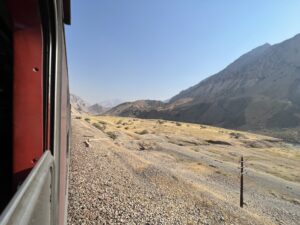
On board on the train to Andimeshk
It was by far the nicest train ride I had ever ridden. The train went through the breathtaking Zagros mountains with scenic views of Iran’s countryside and small towns and villages. During the trip, I took a lot of pictures out of the window which drew some attention from the locals. Some of them started to call somebody on their mobile phones and that was probably how all the problems started.
When arriving in Andimeshk Iranian soldiers were waiting for me on the platform. They brought me to the police station adjacent to the train station. Here the police were waiting for me. They searched my phone and my bag. I was then asked to sit down on a chair and around 8 people which I assumed was a mixture of military personnel, police officers, and secret police started to ask me questions through a translator. Many questions. What I was doing in Iran, what was my route, why I was in Andimeshk and where I was staying, why I had taken so many pictures, how I could afford to travel as I did, what was my further plans in Iran, had I had been to some of the bigger cities in Iran, why I was traveling alone, etc.
It was pretty intimidating. I didn’t feel as if I had done anything wrong, but the rumors about the Iranian authorities arresting foreigners for no just cause were rumbling in my back head. Did I by accident take pictures of some hidden military place or even a glimpse of a nuclear plant? I just didn’t want to end up in an Iranian prison for nothing. It is not a nice place to spend time.
After about an hour of interrogation, they released me and asked me to come back to the police station the next day, one hour before the train was supposed to leave for Dorud.
I didn’t get the best sleep that night. Why should I come back to the police station? Would they contact the headquarter of the secret police (aka the Revolutionary Guard) to assess whether I would be good leverage for Iranian prisoners abroad?
Also, looking out of my hotel window, I could see a white car with 2 persons, parked discreetly opposite the hotel. It was there during the night, also late at night, and even in the morning when I woke up from my troubled sleep. In hindsight, I might have been paranoid from seeing too many spy movies, but the situation was for me a bit tense, and on the whole trip this was the first time I didn’t feel that comfortable being all by myself, far away from home. I anticipated taking a taxi back to Dorud, skipping the appointment at the police station the next day but I decided that could probably have escalated the situation out of control.
So, the next day, after a late breakfast I took a taxi to the police station for my twelve o clock appointment. There was a big knot in my stomach.
When arriving there 7 – 8 people were waiting on me, including the translator. Maybe some of them were the same as the day before, I couldn’t say as I was not introduced to them. Again, my phone was searched, and I was questioned about what I had been doing the night before. I could honestly answer that I had been in my hotel. Then a lot of other questions were asked, some similar to the day before others different. At some point, one of the guys said he admired my blue eyes. Before answering I looked at all the interrogators, they all had brown eyes, and somewhere deep down in my backlog of answers I said: “Oh, I always wished that I had brown eyes”. Based on the smiling faces of my interrogators, I could see that I had scored a point.
After one and a half hours of questioning, I was released and followed to the train, which had waited for about half an hour at the platform. I was placed in a window seat in the first-class coach. On the way back to Dorud I wisely decided not to take any pictures at all.
As said, the whole experience was a bit intimidating. But I should also note, that the interrogators were all polite and civilized. But it was the atmosphere of suspicion as well as the unknown consequences of being detained and interrogated that frightened me the most, especially in light of the riots going on around the country.
When I arrived back in Dorud I was afraid that the police were waiting for me there, but I didn’t see any and took a taxi to my hotel.
The next day I had a long drive to a little village between Isfahan and Yazd where there is a guesthouse well-known by overlanders. Somewhat marked by the experience in Andimeshk I stayed there for about a week, just relaxing and spending time with other overlanders. During my stay, the Iranian authorities decided to shut down the internet throughout the country.
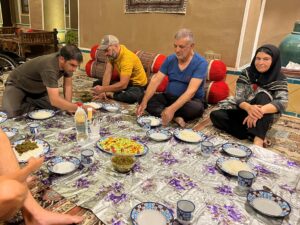
Having dinner at the guesthouse in village
As the riots became tenser I decided to shorten my stay in Iran. From the village I was staying in, I had two and a half days drive to Taftan, the border to Pakistan. That meant that I had to overnight in Kerham and Zehedan.
In Kerman, I slept in Toto in a fenced courtyard of a hotel located in the center. During the night I could hear a lot of police sirens and shootings from the riots outside the hotel.
I left early the next morning and reached Zehedan in the late evening. The drive was through the Sistan-Baluchistan province, Iran’s poorest region. The capital, Zahedan, is one of Iran’s few Sunni-majority cities and the region is populated by the Baluch ethnic minority who adhere to Sunni Islam rather than the Shiism predominant in Iran. Activists have long complained the region has been the victim of discrimination by Iran’s Shiite clerical leadership, with disproportionate numbers of Baluch killed in clashes every year and also hanged in executions. Also, the region has been the scene of attacks on the Iranian security forces that Tehran has blamed on Sunni extremist groups, while the border area is also seen as a hub for drug smuggling by armed gangs
In Zehedan, finding my way to my hotel, I was running out of fuel. The gas stations were all closed. I had to buy some fuel on the roadside, from some of the many black market vendors. I also noticed a lot of police and military present and I learned that the day before there had been what later was named “The Bloody Friday”, the bloodiest day of the nationwide demonstrations at that time. Iranian security forces had opened fire after Friday prayers in the southeastern part of Zahedan, killing at least 66 people with subsequent clashes between the protesters and the police.
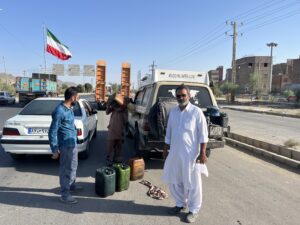
Buying fuel at the roadside
I left Zehedan the next morning and reached the Taftan border in two hours, crossing the border without any issues besides a lot of paperwork.
So, although I only stayed in Iran for two weeks it was quite eventful. I like Iran, but under the given circumstances I felt safer after crossing the border to Pakistan, although some might have difficulties comprehending that.
Deosai National Park:
Going to the Karakoram Mountains in Pakistan had been on my bucket list for many years. As I entered Pakistan at the beginning of October, I had a relatively small window to explore the region as most places in the mountains close down in November due to snow and cold weather.
Coming from Iran, crossing at the Taftan border, I was delayed by a mandatory 24/7 armed escort through the Pakistan part of the Baluchistan province. A lot of waiting and slow driving as the escort will take you from anything from 5 to 50 km at a time and then another escort is waiting for you, which again will take you a certain distance to a new escort and so on. In nights I slept in Toto in police stations. The whole thing took 5 days.
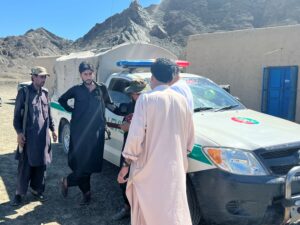
Changing escorts in Baluchistan
However, I came through the escort mayhem and continued north. I reached Gilgit, the hub of the mountain region October 13, just in time to experience the gorgeous foliage throughout the mountains.
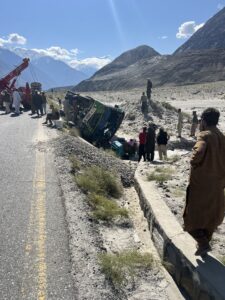
A road accident on the Karakoram Highway
After exploring the infamous Karakoram Highway and some of the adjacent valleys all the way north to the border with China I had one thing left, Deosai National Park. Deosai is the second-highest plateau in the world with an altitude of 4,200 meters above sea level. It is huge, with a total of 358,000 hectares of land and uninhabited except for Himalayan brown bears, snow leopards, and other rare animals. In the summer nomads bring their herds here for grazing but they are gone in the autumn. It takes about 4 hours to drive through the park on small gravel roads.
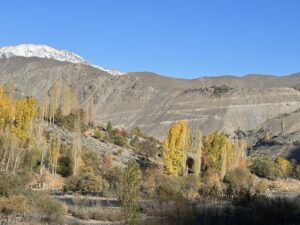
On the way to Deosai Plateau
It is not easy to access, you can reach it from either Skardu or Astore. I chose the latter, not the easiest but the most beautiful. However, the roads there are characterized as “jeep roads” which turned out to be a synonym for narrow, slow, bumpy, and unpaved mountain roads only suited for a 4wd vehicle. Well, Toto was my friend here, but although the distance was only 132 km it took me 9 hours over two days to reach the entrance to Deosai.
The park rangers wouldn’t allow me to enter the park because the whole plateau was covered in snow and they told me that they hadn’t let anybody in for the last 4 days. But after some hours of persuasion and a lot of tea, I was let in. I just assume that they were tired of me arguing about why they should give me access.
Although I had arrived at the entrance late morning, giving me plenty of time to cross the plateau in daylight, the delay caused some time issues. First, I didn’t have time to take detours from the main park road as I didn’t want to drive the plateau in the dark or stay overnight there (the temperature at night could reach as low as -18 degrees Celsius). However, the main route was a small winding gravel road covered in snow so I assume any detour to even smaller snow-covered roads could get me into trouble. Secondly, after exiting Deosai, I still had to descend to Skardu, the nearest city.
Deosai was surreal. I haven’t experienced anything like this in my whole life. It is hard to explain with words. Vast snow-covered high-altitude plains as long as I could see. The majestic 8,000+ meter Nanga Parbat Mountain in the horizon. A deafening silence. I was all alone, driving for hours at an altitude of 4,200 meters. No cell phone signal, hence, no GPS. Not a human soul except me. I slowly followed the snow-covered and quite slippery narrow road, winding its way through the park. The sky was clear blue and almost no clouds. Sheer beauty. I stopped many times to take pictures and the silence around me was incredible, I could almost hear my heartbeat. I was alone in the world.
Sometimes the road had crossroads. I followed some tire tracks made by the rangers, but I was quite often not sure if I was on the right road. However, I just kept going, often through small waterholes, bridges, and snow drifts, and hoped for the best.
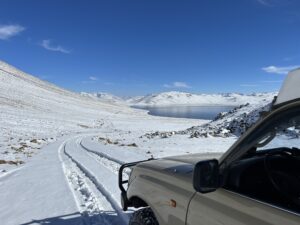
All alone in Deosai
After about three hours of driving, late afternoon, there was a sign for Skardu. Although still within the park, I knew that I was on the right track. It took another hour to reach the end of the plateau and it was getting twilight. I was happy, I got through the park and now I only had to reach Skardu and my prebooked hotel there, an easy task compared to the plateau. I could almost smell the dinner. But I was so wrong.
The road down from Deosai to Skardu takes you from an altitude of 4,200 to 2,200 meters. The road is cut into the mountains and is extremely steep and narrow. I would estimate the gradient to be at least 30%. No guardrails, with the mountain wall on one side and vertical drops of many hundred meters on the other side. If not already listed, it could easily be included in the catalog of the deadliest roads in the world. It was covered in snow, and I could feel the ice below the snow as Toto was sliding a bit when I changed direction on the road. Still not a soul around. And I was getting tired and hungry but didn’t have time for a break as I realized it would be a fight against time if I should not end driving this road in the dark.
I put Toto in first gear and slowly started the descent. The hairpins were so narrow that Toto couldn’t go around them in one turn, so I had to drive halfway around the turn and place the front of Toto as close to the edge of the road as I could. I had to use the brakes as the gradient of the road would easily roll Toto over the edge if not. Then I pulled the handbrake, put Toto in reverse, and slowly lifted the clutch and when I felt that the car was moving backward, I released the handbrake and backed a bit so I had enough space to turn around the hairpin. A slipping foot or fading brakes could easily have brought me and Toto over the edge and ended everything.
After doing around 10 – 15 hairpins, still all alone on the road, my left leg started shaking from exhaustion, making it difficult to make the back-and-forth around the hairpins. I was miserable.
Suddenly I saw a giant 3-foot tripod blocking the road. It looked like a metal frame for a tipi tent. These tripods are, with hoists and shackles, used to lift heavy loads such as machinery, rocks, etc. No signs or warnings for why it was placed there. I stopped on the steep road, put Toto in gear, aimed the front wheels toward the mountain wall, pulled the handbrake, and went out to inspect.
When I was inspecting the tripod, I suddenly heard an engine sound in the distance. Out of nowhere, from the way I had come, an old guy on a motorbike arrived at the scene. Till today, I have no clue where he came from. For the last 4 hours, driving the road where he came from, I hadn’t met a soul or any civilization, and definitely not a motorbiker. The old guy stopped. He was unshaven, and in an old wind jacket but had friendly eyes. I pointed towards the tripod and crossed my arms and asked, “Road closed?”. The old guy shook his head and made a zig-zag movement with his arm, signaling that I could drive under the tripod. Then he pointed down the mountain, made a sliding movement with his hand, and raised one finger while he was shaking his head. He wanted to warn me of something.
I thanked the old guy and got into Toto, continuing the drive down the steep, slippery road. I drove through the tripod carefully, there was exactly enough space to pass. I then saw the old guy waiting for me at the next hairpin. He drove in front of me for some time and further down the road he stopped and pointed at the road in front of a hairpin. I could see the hairpin was very narrow and with negative camber so Toto could easily have slid toward the edge of the road had I not been warned. I slowly went through the hairpin and a bit further down the road, the old guy stopped. When I reached him, I rolled down the window and he said: “Now safe”. Then he waived and drove off.
And it was safe. The rest of the road to Skardu was still narrow but much straighter and as I had come down to lower altitudes I could see the river running not so far below the road. No more hairpins and sheer drops.
I was almost crying. This old guy. How easy would it have been for him just to pass me? Maybe his wife and/or a hot meal was waiting for him. Maybe he was in a hurry, on the way to work? But he stopped because he cared for me, a stranger, all alone, making my way down a slippery, dangerous mountain road. And he came out of nowhere. It was almost a religious moment for me, that old guy was indeed my guardian angel at a time I needed it.
I reached Skardu about half an hour later. I was glad to get out of Toto and enjoy a nice dinner and a comfy bed. But that road sat in me for a long time thereafter. And the old guy in the wind jacket will sit in me forever.

